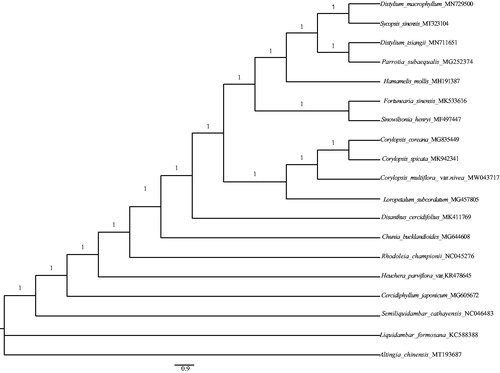Abstract
Corylopsis multiflora Hance var. nivea Chang is a variety of the species C. multiflora in the family Hamamelidaceae and is classed as critically endangered (CR) in the Red List of China Higher Plants. The complete chloroplast genome sequence of this taxon (as C. multiflora var. nivea in GeneBank, accession number: MW043717) was reported in this study. The genome size is 158,993 bp in length, consisting of a pair of inverted repeat regions (IR, 26,213bp), large single copy (LSC, 87,895bp) and small single copy (SSC, 18,672bp). A total of 133 genes were annotated that included 87 protein coding genes (PCGs), 37 transfer RNA (tRNAs), and 8 ribosome RNA (rRNAs) and 1 pseudo gene. GC content were 38.01%. The Bayesian phylogeny tree showed that C. multiflora var. nivea formed a monophyletic branch with Corylopis coreana and Corylopsis spicata.
Corylopsis multiflora Hance var. nivea Chang, a variety of the species C. multiflora in Hamamelidaceae, is only recorded in Fujian Province, unfortunately its habitat has been severely damaged by man disturbance and natural disasters. Therefore, this taxon has been documented as another critically endangered (CR) in the Red List of China Higher Plants (Qin et al. Citation2017). Although the complete chloroplast (cp) genome of a critically endangered species, Distylium tsiangi, in the family was recently published (Xie et al. Citation2020), we added a new cp genome of C. multiflora var. nivea to science for biodiversity conservation and phylogenetic analysis.
The fresh leaves of C. multiflora var. nivea were collected from a mature tree locating at Wuyi Mountains, Nanping city, Fujian Province, China (118.03°E, 27.77°N). The voucher specimen (accession number NF2017745) was reserved at the Herbarium of Nanjing Forestry University (HNFU). Total DNA was extracted using a DNeasy Plant Mini Kit (Vazyme ND607) and sequenced on the Illumina NovaSeq PE150 by Nanjing Genepioneer Biotechnologies Inc (Nanjing, China). A total of 21,534,943 clean reads were detected and assembled with SPAdes v3.10.1 (Bankevich et al. Citation2012). Then, the chloroplast genome was annotated using Prodigal v2.6.3 and Blastv2.6 (Zhang et al. Citation2019). The annotated chloroplast genome sequence of C. multiflora var. nivea was submitted to the NCBI GenBank (as C. multiflora var. nivea) under the accession MW043717.
The complete cp genome sequence of C. multiflora var. nivea contains 158,993 bp with a typical quadripartite structure, which consists of a large single-copy (LSC) region of 87,895 bp, a small single-copy (SSC) region of 18,672 bp and two inverted repeat (IR) regions of 26,213 bp. The overall G + C content of C. multiflora var. nivea chloroplast genome were 38.01%, while the corresponding values of the LSC, SSC, and IR regions were 36.13%, 32.55%, and 43.10%, respectively. The cp genome was composed of 133 genes, which contained 87 protein coding genes (PCGs), 37 transfer RNA genes (tRNAs), 8 ribosomal RNA genes (rRNAs) and 1 pseudo gene. Of these genes. 114 were unique and 18(atpF, clpP, ndhA, ndhB, petB, petD, rpl16, rpl2, rpoC1, rps12, rps16, trnA-UGC, trnG-GCC, trnI-GAU, trnK-UUU, trnL-UAA, trnV-UAC, ycf3) were duplicated in IR regions, 16 of which (ten protein coding genes and six tRNA genes) contained one intron, and two of which (ycf3 and clpP) contained two introns.
To identify the phylogenetic position of C. multiflora var. nivea in Hamamelidaceae, we reconstructed a Bayesian phylogeny tree using MrBayes 3.2.6 (Ronquist et al. Citation2012). A new and highly efficient pipeline, HomBlocks, was employed to construct sequence alignment of several species from Hamamelidaceae (Bi et al. Citation2018). We used a Markov Chain Monte Carlo (MCMC) to run for 2,000,000 generations with four chains through two parallel searches, and each search started from a random tree (Zhang et al. Citation2020). Sampling was performed each 100 generations. The intial 25% of the sampled data was discarded as aging. Our results showed that C. multiflora var. nivea formed a monophyletic branch with Corylopis coreana and Corylopsis spicata (posterior probability =1.0; ). The cp genome sequence of C. multiflora var. nivea can be used to provide genomic resource for further studies.
Acknowledgments
We would like to thank Lei Xie from Nanjing Forestry University for his assistant with data analysis.
Data availability statement
The complete chloroplast genome sequence of C. multiflora var. nivea is deposited in the GenBank database under the accession number MW043717. The Web link is https://www.ncbi.nlm.nih.gov/
Additional information
Funding
References
- Bankevich A, Nurk S, Antipov D, Gurevich AA, Dvorkin M, Kulikov AS, Lesin VM, Nikolenko SI, Pham S, Prjibelski AD, et al. 2012. SPAdes: a new genome assembly algorithm and its applications to single-cell sequencing. J Comput Biol. 19(5):455–477.
- Bi G, Mao Y, Xing Q, Cao M. 2018. HomBlocks: a multiple-alignment construction pipeline for organelle phylogenomics based on locally collinear block searching. Genomics. 110(1):18–22.
- Qin H, Yang Y, Dong S, He Q, Jia Y, Zhao L, Yu S, Liu H, Liu B, Yan Y, et al. 2017. Threatened species list of China’s higher plants. Biodiver Sci. 25(7):696–744.
- Ronquist F, Teslenko M, van der Mark P, Ayres DL, Darling A, Höhna S, Larget B, Liu L, Suchard MA, Huelsenbeck JP, et al. 2012. MrBayes 3.2: efficient Bayesian phylogenetic inference and model choice across a large model space. Syst Biol. 61(3):539–542.
- Xie L, Wang L, Zang M, Chen S, Li Y, Fang Y. 2020. The complete chloroplast genome of Distylium tsiangii Chun ex Walker, a rare and endangered plant. Mitochondrial DNA Part B. 5(1):430–431.
- Zhang KY, Gao YZ, Du MZ, Liu S, Dong C, Guo FB. 2019. Vgas: a viral genome annotation system. Front Microbiol. 10:184.
- Zhang D, Gao F, Jakovlić I, Zou H, Zhang J, Li WX, Wang GT. 2020. PhyloSuite: an integrated and scalable desktop platform for streamlined molecular sequence data management and evolutionary phylogenetics studies. Mol Ecol Resour. 20(1):348–355.

